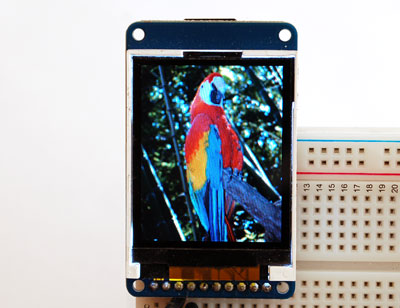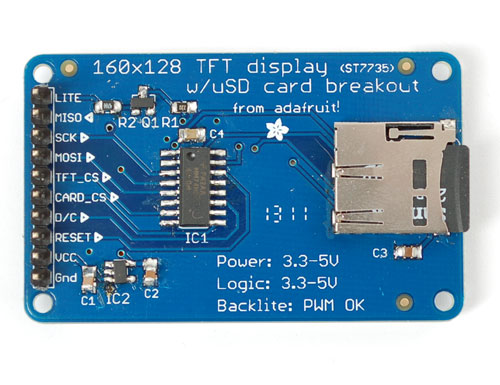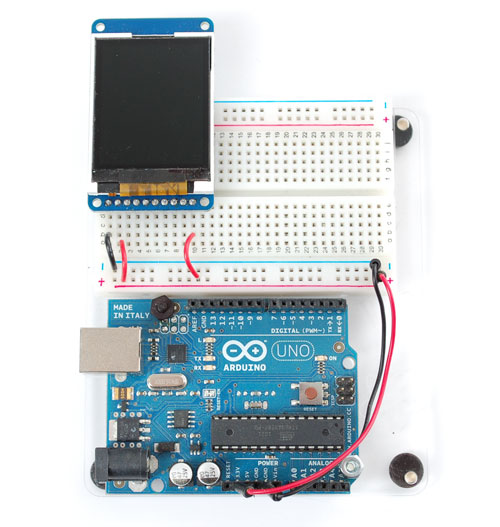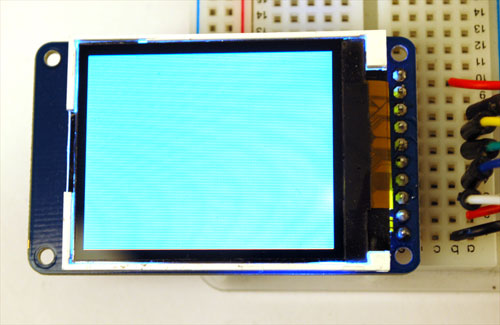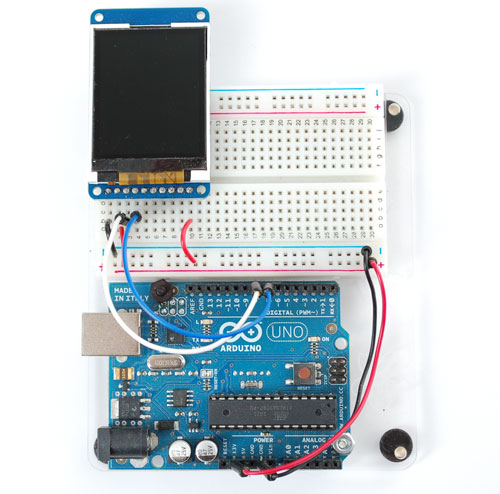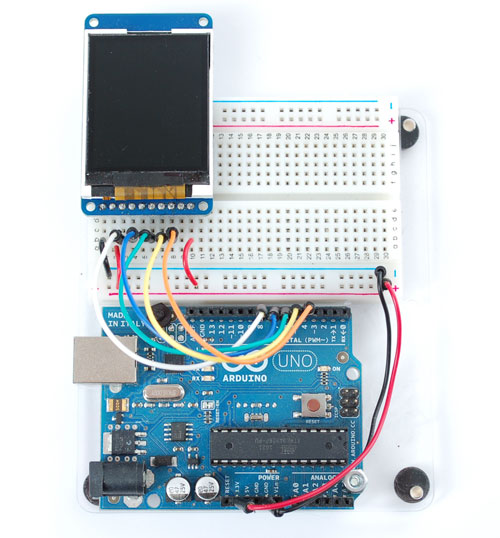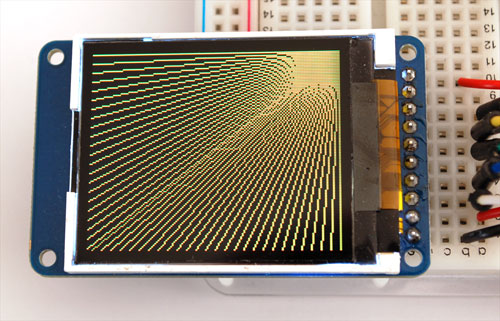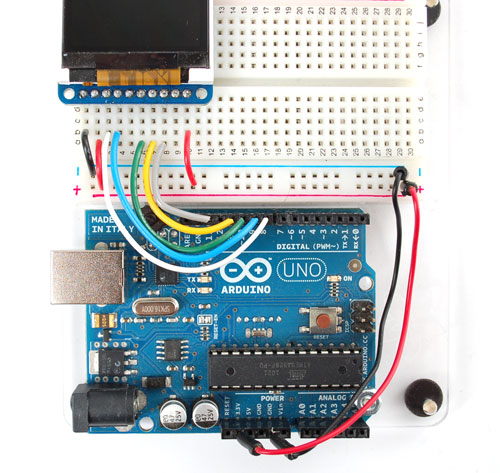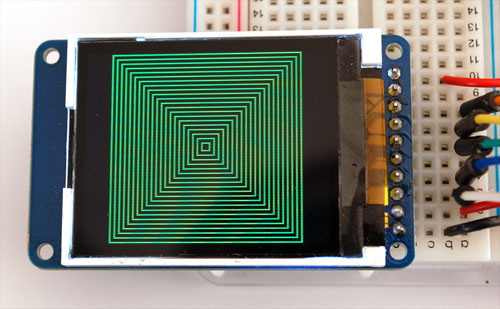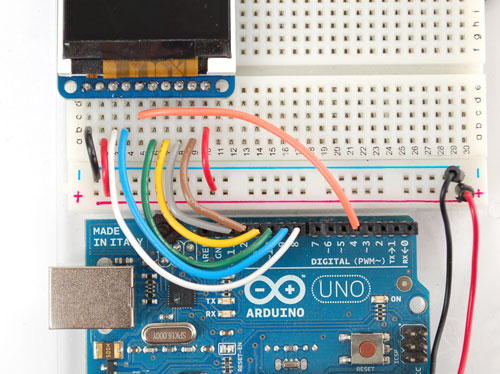Table of Contents
Introduction
This tutorial is for our 1.8" diagonal TFT display & microSD breakout board. This breakout is the best way to add a small, colorful and bright display to any project. Since the display uses 4-wire SPI to communicate and has its own pixel-addressable frame buffer, it can be used with every kind of microcontroller. Even a very small one with low memory and few pins available!
We also have a shield version of this display that is pre-wired for use with an Arduino. Just solder in the headers and you are ready to go!
The 1.8" display has 128x160 color pixels. Unlike the low cost "Nokia 6110" and similar LCD displays, which are CSTN type and thus have poor color and slow refresh, this display is a true TFT! The TFT driver (ST7735R) can display full 18-bit color (262,144 shades!). And the LCD will always come with the same driver chip so there's no worries that your code will not work from one to the other.
The breakout has the TFT soldered on (it uses a delicate flex-circuit connector) as well as a ultra-low-dropout 3.3V regulator and a 3/5V level shifter so you can use it with 3.3V or 5V power and logic. We also had a little space so we placed a microSD card holder so you can easily load full color bitmaps from a FAT16/FAT32 formatted microSD card.
Flexible Wiring
There are two ways to wire up these displays - one is a more flexible method (you can use any pins on the Arduino) and the other is much faster (4-8x faster, but you are required to use the hardware SPI pins) We will begin by showing how to use the more flexible method.
The shield version is pre-wired for hardware SPI. Once you have soldered in the headers, you can skip the wiring instructions and proceed to the "Graphics Library" section for the library code and examples
You can use any 4 or 5 pins for this method. We'll show using pins 4, 5, 6, 7, and 8 and once you have it working, you can change those pins around in the wiring and in the sketch
Start by wiring the power pins.
Connect the leftmost pin to Ground and the next pin to +5V. Connect the rightmost pin (backlight) to 5V as well. If you plug in the Arduino you should see the backlight turn on
Next connect the RESET (TFT reset pin) and D/C (TFT data/command selection pin).
The RESET pin (3rd from the left) connects to Arduino pin 8. The D/C pin (4th from the left) connectso to pin 7
Finally we'll connect the remaining digital pins, TFT_CS (TFT chip select), MOSI (data sent to TFT) and SCK (clock sent to TFT)
Note that you need to skip a pin on the TFT after D/C - the next wire is from TFT_CS which is 6th from the left. This goes to digital pin 6. MOSI (7th from the left) connects to digital pin 5 and finally SCK (8th from the left) connects to digital pin 4
That's it! If you want to change the wiring, you can use any pins but don't forget to change the top of the sketch to match!
//You can use any (4 or) 5 pins #define sclk 4 #define mosi 5 #define cs 6 #define dc 7 #define rst 8 // you can also connect this to the Arduino reset
Test Display
Once you have the display wired up, its time to test your wiring by uploading the example code we have written. Again, we suggest using an Arduino to test.
Download our Arduino library (see bottom of page) from github by clicking on Download in the top right corner. Uncompress the folder and rename it Adafruit_ST7735 - inside the folder you should see the Adafruit_ST7735.cpp and Adafruit_ST7735.h files. Install the Adafruit_ST7735 library foler by placing it in your arduinosketchfolder/libraries folder. You may have to create the libraries subfolder if this is your first library. You can read more about installing libraries in our tutorial
Restart the Arduino IDE. You should now be able to select File > Examples > Adafruit_ST7735 > graphicstest sketch. Upload the sketch to your Arduino wired as above.
Once uploaded, the Arduino should perform all the test display procedures! If you're not seeing anything - first check if you have the backlight on, if the backlight is not lit something is wrong with the power/backlight wiring. If the backlight is lit but you see nothing on the display make sure you're using our suggested wiring
High-speed SPI wiring
If you want to connect to the display and have high-speed data transfer (4-8x faster) you'll have to use the hardware SPI system. This is optimized to be faster than the flexible wiring method (because its built into the hardware of the chip) but you are required to use the hardware SPI pins!
On Atmega 328/168/8 type Arduinos ('classic' type) the hardware SPI pins are 11 (MOSI), 13 (SCK) and 10 (CS). For Megas it is 51 (MOSI), 52 (SCK), and 53 (CS). The CS pin can be a different pin but if you use any other pin you must still have the hardware SPI CS pin (10 or 53) as an output!
We will also change the TFT_CS pin to be pin 10 and D/C to be pin 9 (you can change these two later but pin 10 must always be an output for hardware SPI to work)
Select the File > Examples > Adafruit_ST7735 > graphicstest_highspeed sketch. Upload the sketch to your Arduino wired as above.
In the sketch we changed the pin definitions
//#define sclk 13 // for MEGAs use pin 52 //#define mosi 11 // for MEGAs use pin 51 #define cs 10 // for MEGAs you probably want this to be pin 53 #define dc 9 #define rst 8 // you can also connect this to the Arduino reset
To use the hardware SPI, we commented out this line
// Option 1: use any pins but a little slower // Adafruit_ST7735 tft = Adafruit_ST7735(cs, dc, mosi, sclk, rst);
and uncommented this line:
// Option 2: must use the hardware SPI pins // (for UNO thats sclk = 13 and sid = 11) and pin 10 must be // an output. This is much faster - also required if you want // to use the microSD card (see the image drawing example) Adafruit_ST7735 tft = Adafruit_ST7735(cs, dc, rst);
Now when you run the graphics test you'll notice its much faster
If you want to usethe microSD card and TFT at the same time, you'll need to use the hardware SPI because the SPI pins are shared between the two. See the bitmaps tutorial below for details on how to do this
Graphics Library
We've written a full graphics library specifically for this display which will get you up and running quickly. The code is written in C/C++ for Arduino but is easy to port to any microcontroller by rewritting the low level pin access functions.
The TFT LCD library is based off of the Adafruit GFX graphics core library. GFX has many ready to go functions that should help you start out with your project. Its not exhaustive and we'll try to update it if we find a really useful function. Right now it supports pixels, lines, rectangles, circles, round-rects, triangles and printing text as well as rotation.
Two libraries need to be downloaded and installed: first is the ST7735 library (this contains the low-level code specific to this device), and second is the Adafruit GFX Library (which handles graphics operations common to many displays we carry). Download both ZIP files, uncompress and rename the folders to 'Adafruit_ST7735' and 'Adafruit_GFX' respectively, place them inside your Arduino libraries folder and restart the Arduino IDE. If this is all unfamiliar, we have a tutorial introducing Arduino library concepts and installation.
Check out the GFX tutorial for detailed information about what is supported and how to use it!
Displaying bitmaps
In this example, we'll show how to display a 128x160 pixel full color bitmap from a microSD card
We have an example sketch in the library showing how to display full color bitmap images stored on an SD card. You'll need a microSD card such as this one . You'll also need to download our SD library modified to allow faster reads (these changes will hopefully be added to arduino v23) but for now you can download the new library here . Download the library by clicking the Downloads button and uncompressing the folder. Replace the files in your ArduinoIDE/libraries/SD folder (make a backup of course) and restart the IDE.
You'll also need an image. We suggest starting with this bitmap of a parrot. If you want to later use your own image, use an image editing tool and crop your image to no larger than 160 pixels high and 128 pixels wide. Save it as a 24-bit color BMP file - it must be 24-bit color format to work, even if it was originally a 16-bit color image - becaue of the way BMPs are stored and displayed!
Copy the parrot.bmp to the microSD card and insert it into the back of the breakout board
Wire up the TFT according to the high-speed SPI diagram above. Test that your wiring is correct by uploading the graphics test sketch with the high speed SPI line uncommented and the flexible-low-speed wiring commented.
Once you are sure that the TFT is wired correctly, add the two wires for talking to the SD card. Connect CARD_CS (the unconnected pin in the middle) to digital pin 4 (you can change this later to any pin you want). Connect MISO (second from the right) to the Arduino's hardware SPI MISO pin. For Classic arduinos, this is pin 12. For Mega's this is pin 50. You can't change the MISO pin, its fixed in the chip hardware
Now load the bitmap example sketch into the Arduino. It should display the parrot image. If you have any problems, check the serial console for any messages such as not being able to initialize the microSD card or not finding the image.

Download
Adafruit GFX library.
Adafruit ST7735 library.
(See our detailed tutorial for installation assistance.)
For shield users, see the "shieldtest.pde" example in the ST7735 library.
You may also be interested in the datasheet for the display, and display driver chip

